Nursing Priorities within First 24 Hours of Total Knee Replacement Surgery
VerifiedAdded on 2022/11/18
|11
|3043
|331
AI Summary
This nursing assignment is based on the case study of Mr Frank Wright, a 76 years old man who has undergone total replacement surgery of the right knee. The paper will focus on the three nursing priorities within first 24 hours of surgery. Mainly in the first part of the assignment, post-surgical plan will be illustrated with the help of clinical reasoning cycle. The second part of the assignment will cover the complication that must be associated with pathophysiology of obstructive sleep apnoea and smoking and how it affects post-surgical recovery and during general anaesthesia. This part will also focus on co-morbidities associated with smoking and obstructive sleep apnea and nursing interventions to overcome those complications. The third part of the assignment will discuss the discharge planning of the patient, Mr Wright following the total knee replacement surgery.
Contribute Materials
Your contribution can guide someone’s learning journey. Share your
documents today.

Running head: NURSING
Nursing
Name of the Student
Name of the University
Author Note
Nursing
Name of the Student
Name of the University
Author Note
Secure Best Marks with AI Grader
Need help grading? Try our AI Grader for instant feedback on your assignments.
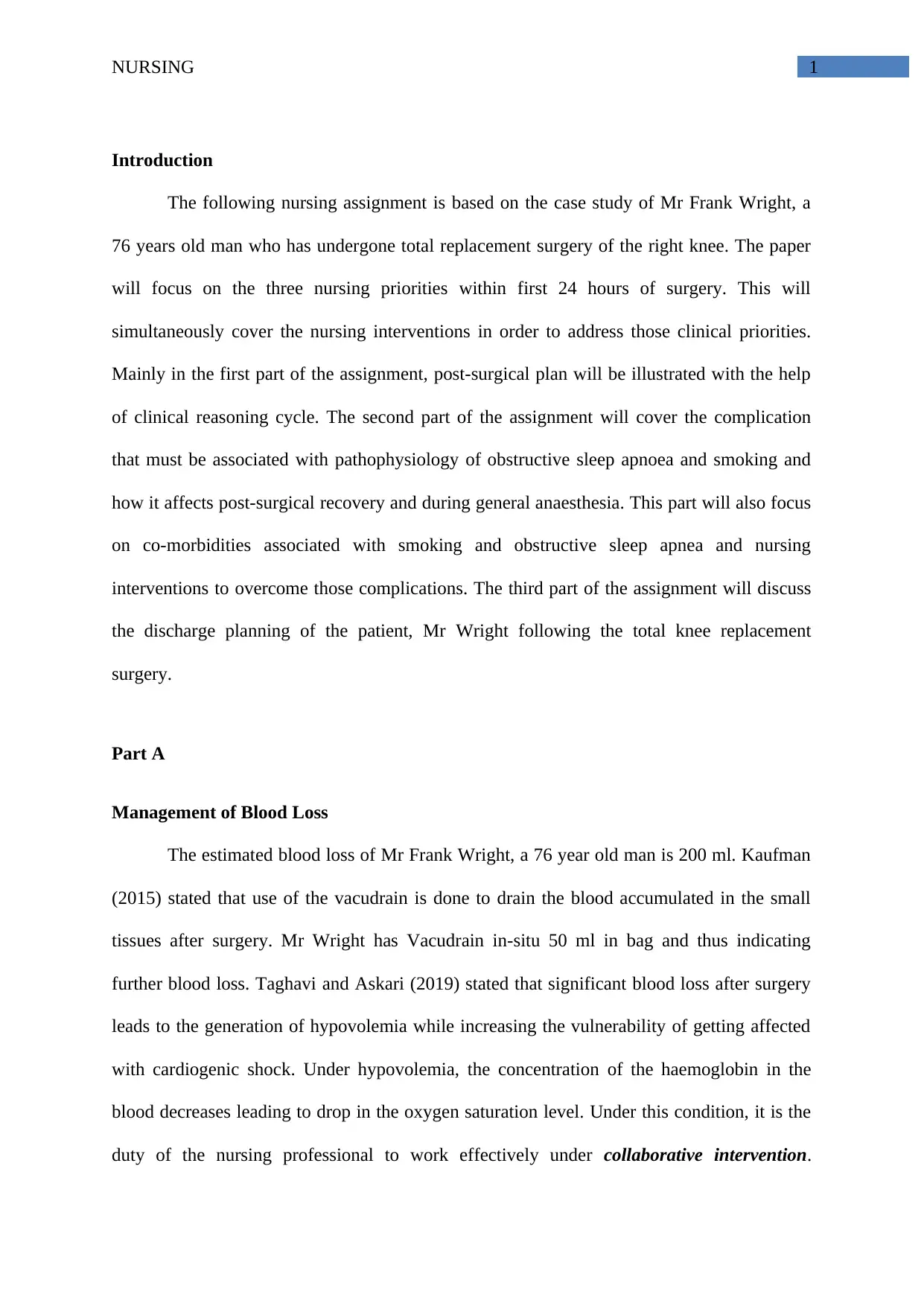
1NURSING
Introduction
The following nursing assignment is based on the case study of Mr Frank Wright, a
76 years old man who has undergone total replacement surgery of the right knee. The paper
will focus on the three nursing priorities within first 24 hours of surgery. This will
simultaneously cover the nursing interventions in order to address those clinical priorities.
Mainly in the first part of the assignment, post-surgical plan will be illustrated with the help
of clinical reasoning cycle. The second part of the assignment will cover the complication
that must be associated with pathophysiology of obstructive sleep apnoea and smoking and
how it affects post-surgical recovery and during general anaesthesia. This part will also focus
on co-morbidities associated with smoking and obstructive sleep apnea and nursing
interventions to overcome those complications. The third part of the assignment will discuss
the discharge planning of the patient, Mr Wright following the total knee replacement
surgery.
Part A
Management of Blood Loss
The estimated blood loss of Mr Frank Wright, a 76 year old man is 200 ml. Kaufman
(2015) stated that use of the vacudrain is done to drain the blood accumulated in the small
tissues after surgery. Mr Wright has Vacudrain in-situ 50 ml in bag and thus indicating
further blood loss. Taghavi and Askari (2019) stated that significant blood loss after surgery
leads to the generation of hypovolemia while increasing the vulnerability of getting affected
with cardiogenic shock. Under hypovolemia, the concentration of the haemoglobin in the
blood decreases leading to drop in the oxygen saturation level. Under this condition, it is the
duty of the nursing professional to work effectively under collaborative intervention.
Introduction
The following nursing assignment is based on the case study of Mr Frank Wright, a
76 years old man who has undergone total replacement surgery of the right knee. The paper
will focus on the three nursing priorities within first 24 hours of surgery. This will
simultaneously cover the nursing interventions in order to address those clinical priorities.
Mainly in the first part of the assignment, post-surgical plan will be illustrated with the help
of clinical reasoning cycle. The second part of the assignment will cover the complication
that must be associated with pathophysiology of obstructive sleep apnoea and smoking and
how it affects post-surgical recovery and during general anaesthesia. This part will also focus
on co-morbidities associated with smoking and obstructive sleep apnea and nursing
interventions to overcome those complications. The third part of the assignment will discuss
the discharge planning of the patient, Mr Wright following the total knee replacement
surgery.
Part A
Management of Blood Loss
The estimated blood loss of Mr Frank Wright, a 76 year old man is 200 ml. Kaufman
(2015) stated that use of the vacudrain is done to drain the blood accumulated in the small
tissues after surgery. Mr Wright has Vacudrain in-situ 50 ml in bag and thus indicating
further blood loss. Taghavi and Askari (2019) stated that significant blood loss after surgery
leads to the generation of hypovolemia while increasing the vulnerability of getting affected
with cardiogenic shock. Under hypovolemia, the concentration of the haemoglobin in the
blood decreases leading to drop in the oxygen saturation level. Under this condition, it is the
duty of the nursing professional to work effectively under collaborative intervention.
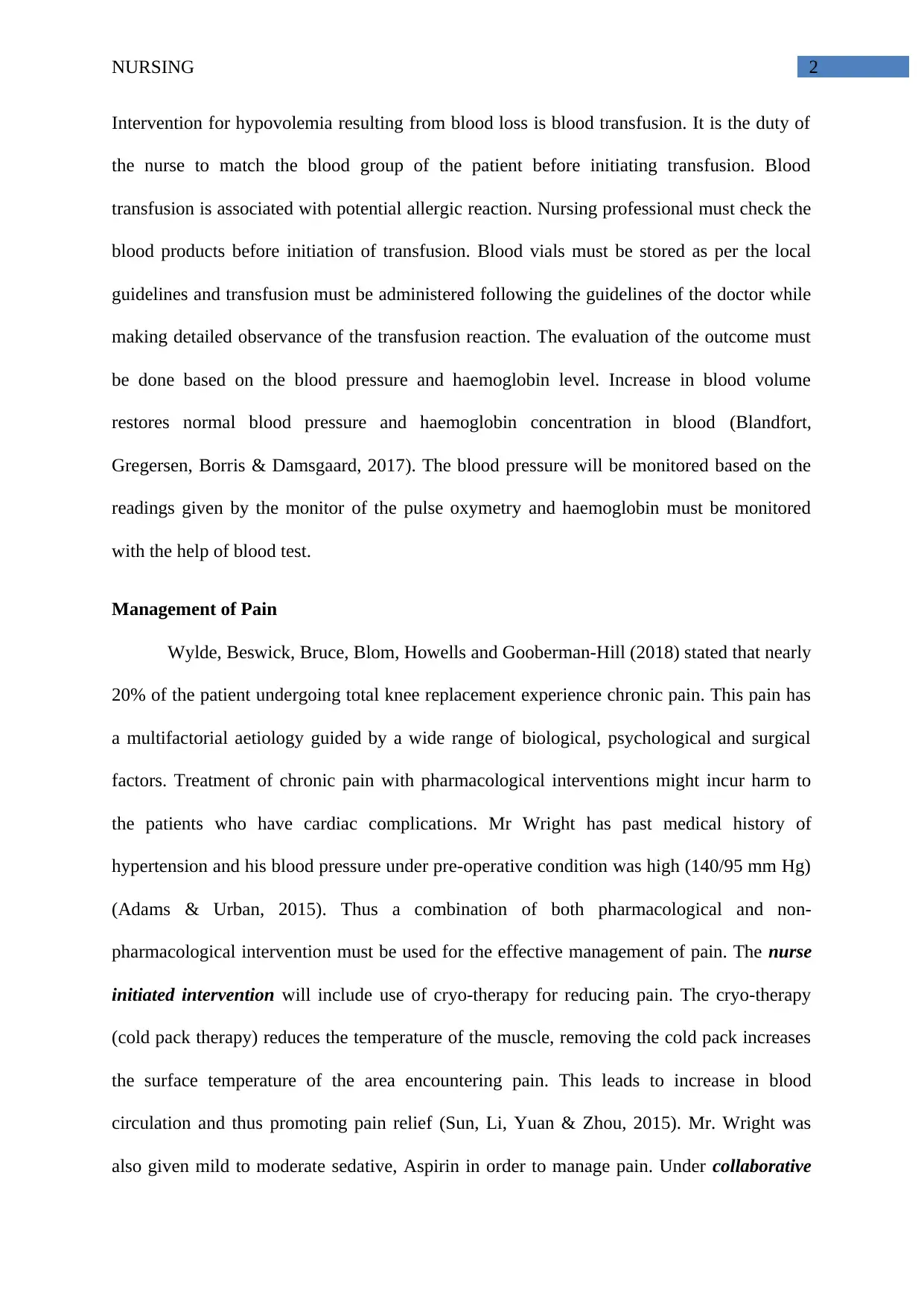
2NURSING
Intervention for hypovolemia resulting from blood loss is blood transfusion. It is the duty of
the nurse to match the blood group of the patient before initiating transfusion. Blood
transfusion is associated with potential allergic reaction. Nursing professional must check the
blood products before initiation of transfusion. Blood vials must be stored as per the local
guidelines and transfusion must be administered following the guidelines of the doctor while
making detailed observance of the transfusion reaction. The evaluation of the outcome must
be done based on the blood pressure and haemoglobin level. Increase in blood volume
restores normal blood pressure and haemoglobin concentration in blood (Blandfort,
Gregersen, Borris & Damsgaard, 2017). The blood pressure will be monitored based on the
readings given by the monitor of the pulse oxymetry and haemoglobin must be monitored
with the help of blood test.
Management of Pain
Wylde, Beswick, Bruce, Blom, Howells and Gooberman-Hill (2018) stated that nearly
20% of the patient undergoing total knee replacement experience chronic pain. This pain has
a multifactorial aetiology guided by a wide range of biological, psychological and surgical
factors. Treatment of chronic pain with pharmacological interventions might incur harm to
the patients who have cardiac complications. Mr Wright has past medical history of
hypertension and his blood pressure under pre-operative condition was high (140/95 mm Hg)
(Adams & Urban, 2015). Thus a combination of both pharmacological and non-
pharmacological intervention must be used for the effective management of pain. The nurse
initiated intervention will include use of cryo-therapy for reducing pain. The cryo-therapy
(cold pack therapy) reduces the temperature of the muscle, removing the cold pack increases
the surface temperature of the area encountering pain. This leads to increase in blood
circulation and thus promoting pain relief (Sun, Li, Yuan & Zhou, 2015). Mr. Wright was
also given mild to moderate sedative, Aspirin in order to manage pain. Under collaborative
Intervention for hypovolemia resulting from blood loss is blood transfusion. It is the duty of
the nurse to match the blood group of the patient before initiating transfusion. Blood
transfusion is associated with potential allergic reaction. Nursing professional must check the
blood products before initiation of transfusion. Blood vials must be stored as per the local
guidelines and transfusion must be administered following the guidelines of the doctor while
making detailed observance of the transfusion reaction. The evaluation of the outcome must
be done based on the blood pressure and haemoglobin level. Increase in blood volume
restores normal blood pressure and haemoglobin concentration in blood (Blandfort,
Gregersen, Borris & Damsgaard, 2017). The blood pressure will be monitored based on the
readings given by the monitor of the pulse oxymetry and haemoglobin must be monitored
with the help of blood test.
Management of Pain
Wylde, Beswick, Bruce, Blom, Howells and Gooberman-Hill (2018) stated that nearly
20% of the patient undergoing total knee replacement experience chronic pain. This pain has
a multifactorial aetiology guided by a wide range of biological, psychological and surgical
factors. Treatment of chronic pain with pharmacological interventions might incur harm to
the patients who have cardiac complications. Mr Wright has past medical history of
hypertension and his blood pressure under pre-operative condition was high (140/95 mm Hg)
(Adams & Urban, 2015). Thus a combination of both pharmacological and non-
pharmacological intervention must be used for the effective management of pain. The nurse
initiated intervention will include use of cryo-therapy for reducing pain. The cryo-therapy
(cold pack therapy) reduces the temperature of the muscle, removing the cold pack increases
the surface temperature of the area encountering pain. This leads to increase in blood
circulation and thus promoting pain relief (Sun, Li, Yuan & Zhou, 2015). Mr. Wright was
also given mild to moderate sedative, Aspirin in order to manage pain. Under collaborative
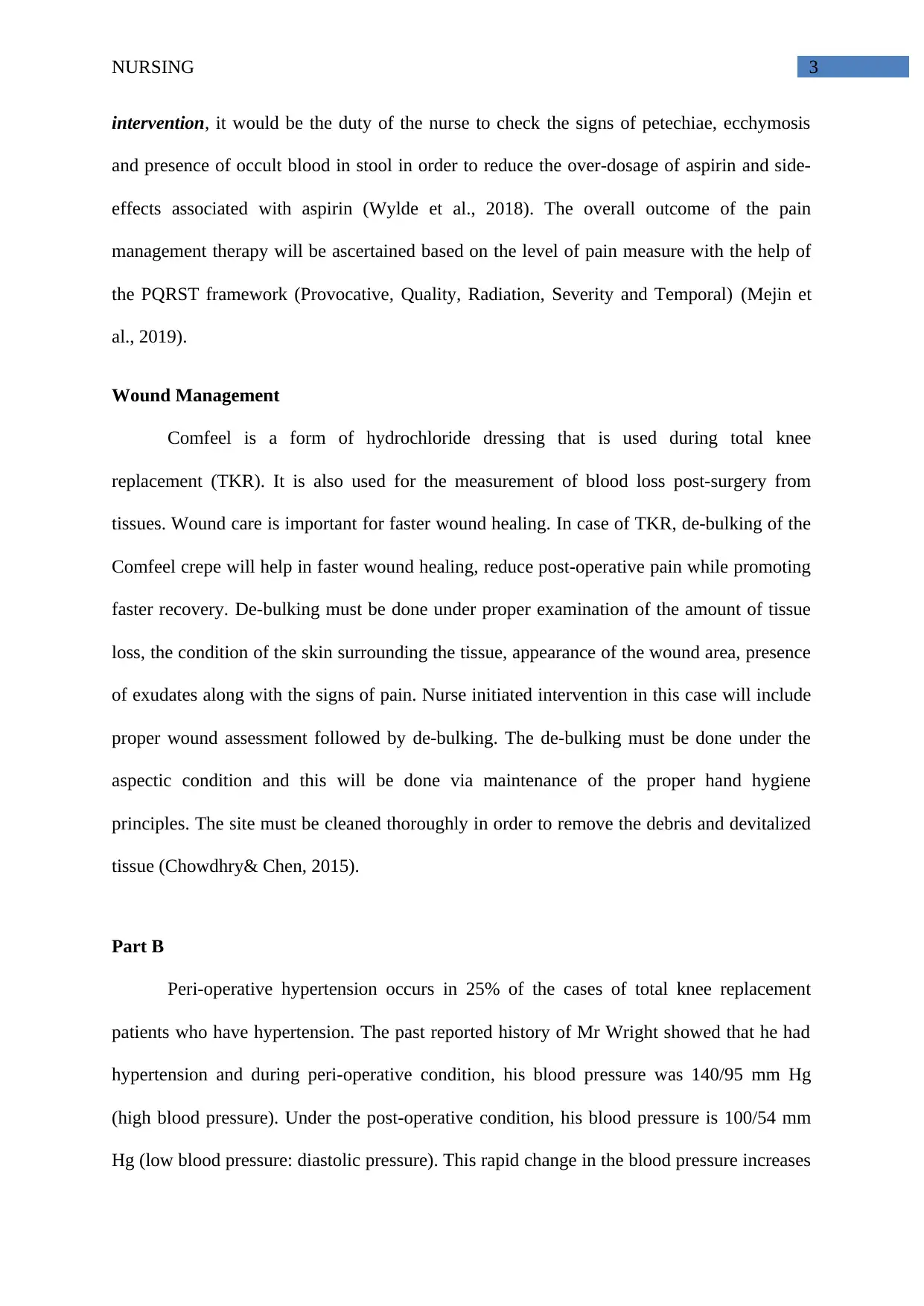
3NURSING
intervention, it would be the duty of the nurse to check the signs of petechiae, ecchymosis
and presence of occult blood in stool in order to reduce the over-dosage of aspirin and side-
effects associated with aspirin (Wylde et al., 2018). The overall outcome of the pain
management therapy will be ascertained based on the level of pain measure with the help of
the PQRST framework (Provocative, Quality, Radiation, Severity and Temporal) (Mejin et
al., 2019).
Wound Management
Comfeel is a form of hydrochloride dressing that is used during total knee
replacement (TKR). It is also used for the measurement of blood loss post-surgery from
tissues. Wound care is important for faster wound healing. In case of TKR, de-bulking of the
Comfeel crepe will help in faster wound healing, reduce post-operative pain while promoting
faster recovery. De-bulking must be done under proper examination of the amount of tissue
loss, the condition of the skin surrounding the tissue, appearance of the wound area, presence
of exudates along with the signs of pain. Nurse initiated intervention in this case will include
proper wound assessment followed by de-bulking. The de-bulking must be done under the
aspectic condition and this will be done via maintenance of the proper hand hygiene
principles. The site must be cleaned thoroughly in order to remove the debris and devitalized
tissue (Chowdhry& Chen, 2015).
Part B
Peri-operative hypertension occurs in 25% of the cases of total knee replacement
patients who have hypertension. The past reported history of Mr Wright showed that he had
hypertension and during peri-operative condition, his blood pressure was 140/95 mm Hg
(high blood pressure). Under the post-operative condition, his blood pressure is 100/54 mm
Hg (low blood pressure: diastolic pressure). This rapid change in the blood pressure increases
intervention, it would be the duty of the nurse to check the signs of petechiae, ecchymosis
and presence of occult blood in stool in order to reduce the over-dosage of aspirin and side-
effects associated with aspirin (Wylde et al., 2018). The overall outcome of the pain
management therapy will be ascertained based on the level of pain measure with the help of
the PQRST framework (Provocative, Quality, Radiation, Severity and Temporal) (Mejin et
al., 2019).
Wound Management
Comfeel is a form of hydrochloride dressing that is used during total knee
replacement (TKR). It is also used for the measurement of blood loss post-surgery from
tissues. Wound care is important for faster wound healing. In case of TKR, de-bulking of the
Comfeel crepe will help in faster wound healing, reduce post-operative pain while promoting
faster recovery. De-bulking must be done under proper examination of the amount of tissue
loss, the condition of the skin surrounding the tissue, appearance of the wound area, presence
of exudates along with the signs of pain. Nurse initiated intervention in this case will include
proper wound assessment followed by de-bulking. The de-bulking must be done under the
aspectic condition and this will be done via maintenance of the proper hand hygiene
principles. The site must be cleaned thoroughly in order to remove the debris and devitalized
tissue (Chowdhry& Chen, 2015).
Part B
Peri-operative hypertension occurs in 25% of the cases of total knee replacement
patients who have hypertension. The past reported history of Mr Wright showed that he had
hypertension and during peri-operative condition, his blood pressure was 140/95 mm Hg
(high blood pressure). Under the post-operative condition, his blood pressure is 100/54 mm
Hg (low blood pressure: diastolic pressure). This rapid change in the blood pressure increases
Secure Best Marks with AI Grader
Need help grading? Try our AI Grader for instant feedback on your assignments.
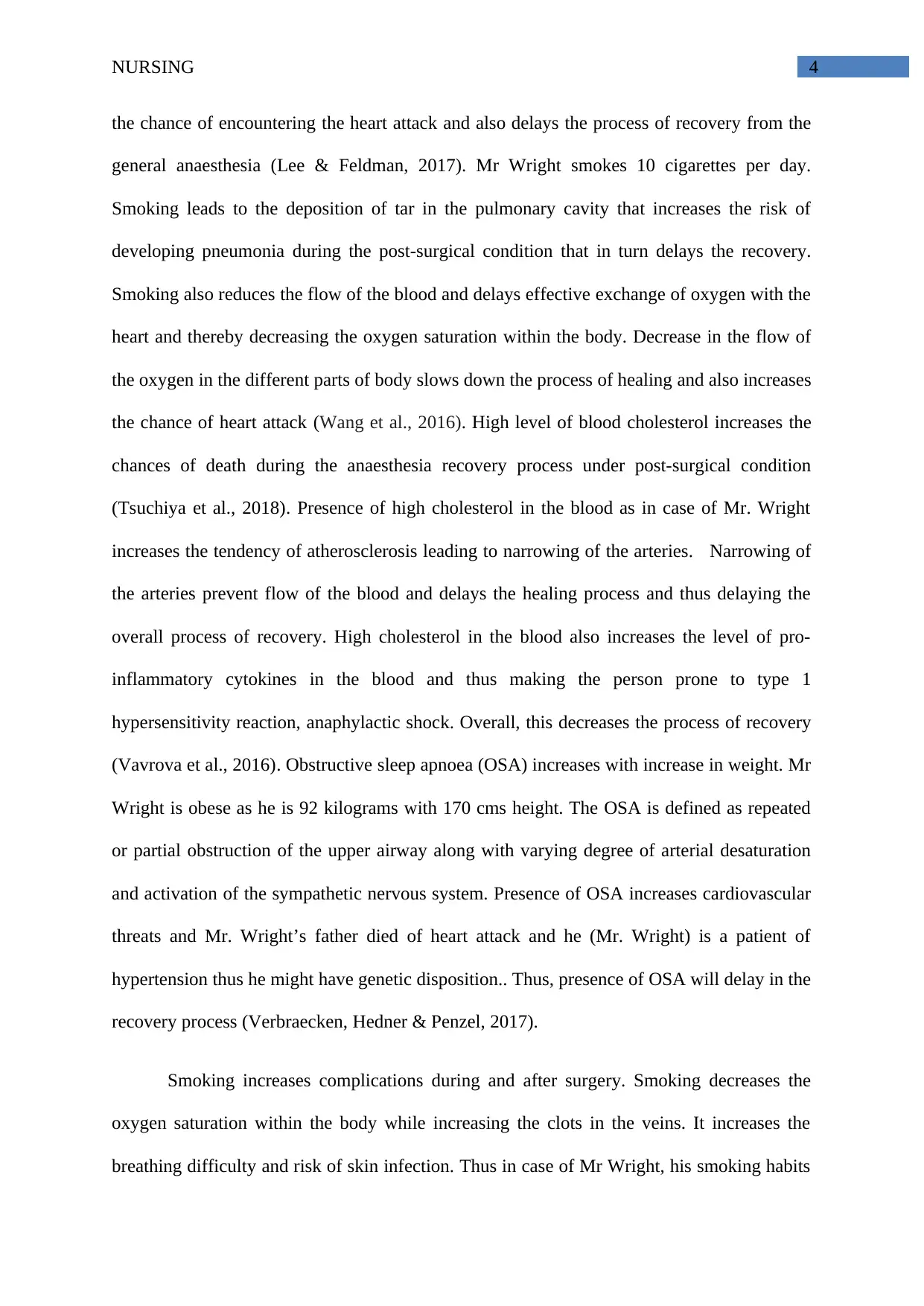
4NURSING
the chance of encountering the heart attack and also delays the process of recovery from the
general anaesthesia (Lee & Feldman, 2017). Mr Wright smokes 10 cigarettes per day.
Smoking leads to the deposition of tar in the pulmonary cavity that increases the risk of
developing pneumonia during the post-surgical condition that in turn delays the recovery.
Smoking also reduces the flow of the blood and delays effective exchange of oxygen with the
heart and thereby decreasing the oxygen saturation within the body. Decrease in the flow of
the oxygen in the different parts of body slows down the process of healing and also increases
the chance of heart attack (Wang et al., 2016). High level of blood cholesterol increases the
chances of death during the anaesthesia recovery process under post-surgical condition
(Tsuchiya et al., 2018). Presence of high cholesterol in the blood as in case of Mr. Wright
increases the tendency of atherosclerosis leading to narrowing of the arteries. Narrowing of
the arteries prevent flow of the blood and delays the healing process and thus delaying the
overall process of recovery. High cholesterol in the blood also increases the level of pro-
inflammatory cytokines in the blood and thus making the person prone to type 1
hypersensitivity reaction, anaphylactic shock. Overall, this decreases the process of recovery
(Vavrova et al., 2016). Obstructive sleep apnoea (OSA) increases with increase in weight. Mr
Wright is obese as he is 92 kilograms with 170 cms height. The OSA is defined as repeated
or partial obstruction of the upper airway along with varying degree of arterial desaturation
and activation of the sympathetic nervous system. Presence of OSA increases cardiovascular
threats and Mr. Wright’s father died of heart attack and he (Mr. Wright) is a patient of
hypertension thus he might have genetic disposition.. Thus, presence of OSA will delay in the
recovery process (Verbraecken, Hedner & Penzel, 2017).
Smoking increases complications during and after surgery. Smoking decreases the
oxygen saturation within the body while increasing the clots in the veins. It increases the
breathing difficulty and risk of skin infection. Thus in case of Mr Wright, his smoking habits
the chance of encountering the heart attack and also delays the process of recovery from the
general anaesthesia (Lee & Feldman, 2017). Mr Wright smokes 10 cigarettes per day.
Smoking leads to the deposition of tar in the pulmonary cavity that increases the risk of
developing pneumonia during the post-surgical condition that in turn delays the recovery.
Smoking also reduces the flow of the blood and delays effective exchange of oxygen with the
heart and thereby decreasing the oxygen saturation within the body. Decrease in the flow of
the oxygen in the different parts of body slows down the process of healing and also increases
the chance of heart attack (Wang et al., 2016). High level of blood cholesterol increases the
chances of death during the anaesthesia recovery process under post-surgical condition
(Tsuchiya et al., 2018). Presence of high cholesterol in the blood as in case of Mr. Wright
increases the tendency of atherosclerosis leading to narrowing of the arteries. Narrowing of
the arteries prevent flow of the blood and delays the healing process and thus delaying the
overall process of recovery. High cholesterol in the blood also increases the level of pro-
inflammatory cytokines in the blood and thus making the person prone to type 1
hypersensitivity reaction, anaphylactic shock. Overall, this decreases the process of recovery
(Vavrova et al., 2016). Obstructive sleep apnoea (OSA) increases with increase in weight. Mr
Wright is obese as he is 92 kilograms with 170 cms height. The OSA is defined as repeated
or partial obstruction of the upper airway along with varying degree of arterial desaturation
and activation of the sympathetic nervous system. Presence of OSA increases cardiovascular
threats and Mr. Wright’s father died of heart attack and he (Mr. Wright) is a patient of
hypertension thus he might have genetic disposition.. Thus, presence of OSA will delay in the
recovery process (Verbraecken, Hedner & Penzel, 2017).
Smoking increases complications during and after surgery. Smoking decreases the
oxygen saturation within the body while increasing the clots in the veins. It increases the
breathing difficulty and risk of skin infection. Thus in case of Mr Wright, his smoking habits
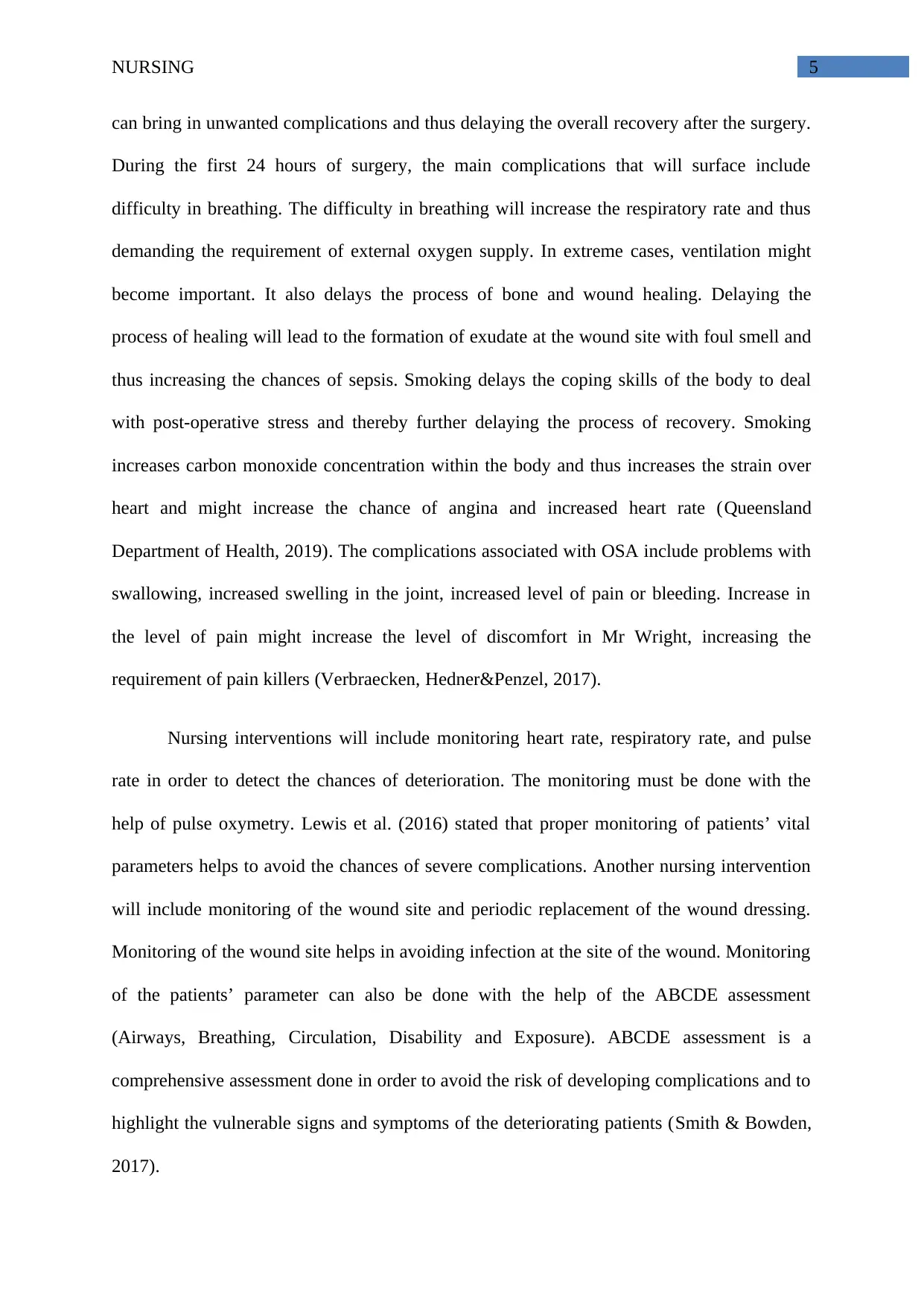
5NURSING
can bring in unwanted complications and thus delaying the overall recovery after the surgery.
During the first 24 hours of surgery, the main complications that will surface include
difficulty in breathing. The difficulty in breathing will increase the respiratory rate and thus
demanding the requirement of external oxygen supply. In extreme cases, ventilation might
become important. It also delays the process of bone and wound healing. Delaying the
process of healing will lead to the formation of exudate at the wound site with foul smell and
thus increasing the chances of sepsis. Smoking delays the coping skills of the body to deal
with post-operative stress and thereby further delaying the process of recovery. Smoking
increases carbon monoxide concentration within the body and thus increases the strain over
heart and might increase the chance of angina and increased heart rate (Queensland
Department of Health, 2019). The complications associated with OSA include problems with
swallowing, increased swelling in the joint, increased level of pain or bleeding. Increase in
the level of pain might increase the level of discomfort in Mr Wright, increasing the
requirement of pain killers (Verbraecken, Hedner&Penzel, 2017).
Nursing interventions will include monitoring heart rate, respiratory rate, and pulse
rate in order to detect the chances of deterioration. The monitoring must be done with the
help of pulse oxymetry. Lewis et al. (2016) stated that proper monitoring of patients’ vital
parameters helps to avoid the chances of severe complications. Another nursing intervention
will include monitoring of the wound site and periodic replacement of the wound dressing.
Monitoring of the wound site helps in avoiding infection at the site of the wound. Monitoring
of the patients’ parameter can also be done with the help of the ABCDE assessment
(Airways, Breathing, Circulation, Disability and Exposure). ABCDE assessment is a
comprehensive assessment done in order to avoid the risk of developing complications and to
highlight the vulnerable signs and symptoms of the deteriorating patients (Smith & Bowden,
2017).
can bring in unwanted complications and thus delaying the overall recovery after the surgery.
During the first 24 hours of surgery, the main complications that will surface include
difficulty in breathing. The difficulty in breathing will increase the respiratory rate and thus
demanding the requirement of external oxygen supply. In extreme cases, ventilation might
become important. It also delays the process of bone and wound healing. Delaying the
process of healing will lead to the formation of exudate at the wound site with foul smell and
thus increasing the chances of sepsis. Smoking delays the coping skills of the body to deal
with post-operative stress and thereby further delaying the process of recovery. Smoking
increases carbon monoxide concentration within the body and thus increases the strain over
heart and might increase the chance of angina and increased heart rate (Queensland
Department of Health, 2019). The complications associated with OSA include problems with
swallowing, increased swelling in the joint, increased level of pain or bleeding. Increase in
the level of pain might increase the level of discomfort in Mr Wright, increasing the
requirement of pain killers (Verbraecken, Hedner&Penzel, 2017).
Nursing interventions will include monitoring heart rate, respiratory rate, and pulse
rate in order to detect the chances of deterioration. The monitoring must be done with the
help of pulse oxymetry. Lewis et al. (2016) stated that proper monitoring of patients’ vital
parameters helps to avoid the chances of severe complications. Another nursing intervention
will include monitoring of the wound site and periodic replacement of the wound dressing.
Monitoring of the wound site helps in avoiding infection at the site of the wound. Monitoring
of the patients’ parameter can also be done with the help of the ABCDE assessment
(Airways, Breathing, Circulation, Disability and Exposure). ABCDE assessment is a
comprehensive assessment done in order to avoid the risk of developing complications and to
highlight the vulnerable signs and symptoms of the deteriorating patients (Smith & Bowden,
2017).
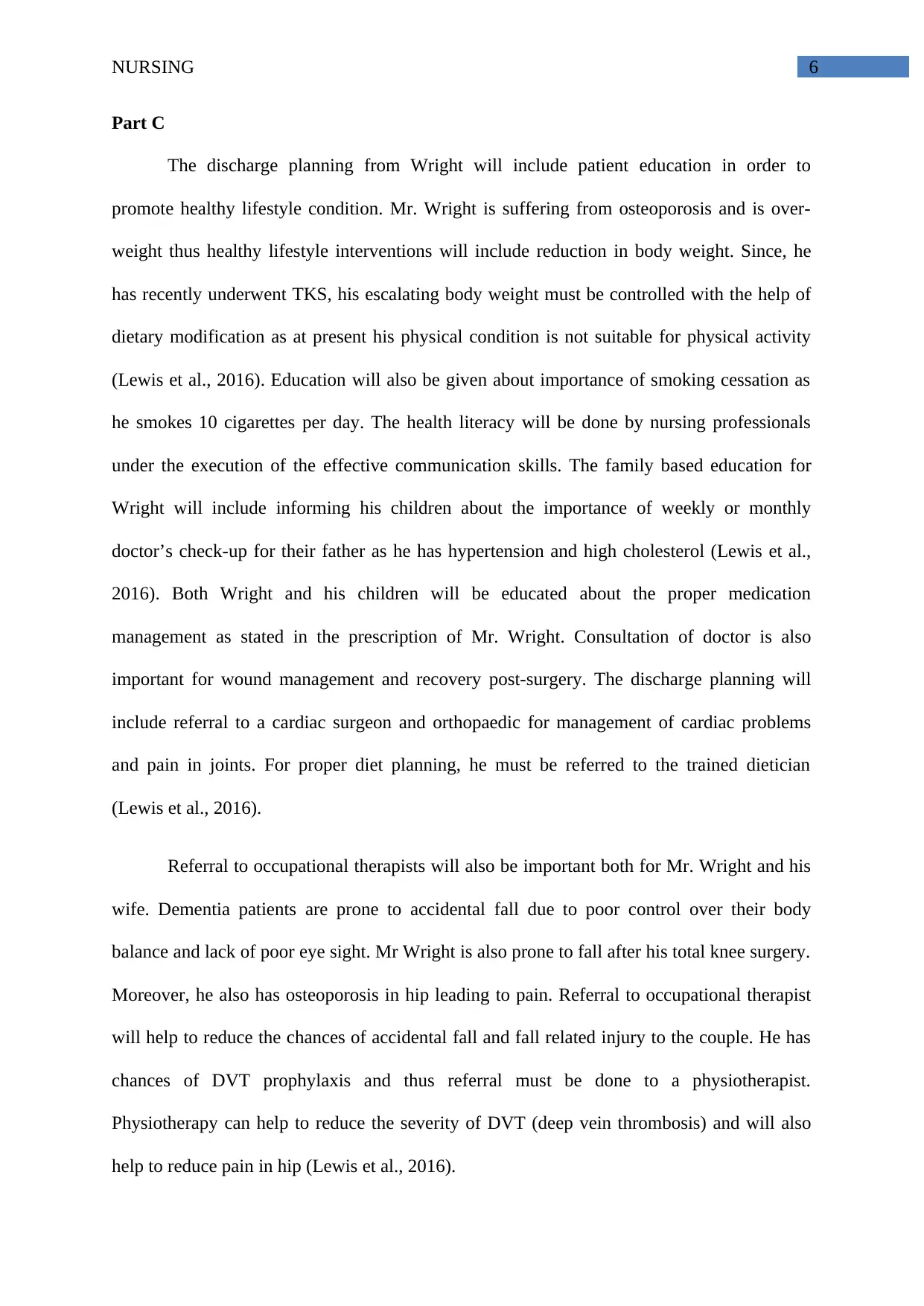
6NURSING
Part C
The discharge planning from Wright will include patient education in order to
promote healthy lifestyle condition. Mr. Wright is suffering from osteoporosis and is over-
weight thus healthy lifestyle interventions will include reduction in body weight. Since, he
has recently underwent TKS, his escalating body weight must be controlled with the help of
dietary modification as at present his physical condition is not suitable for physical activity
(Lewis et al., 2016). Education will also be given about importance of smoking cessation as
he smokes 10 cigarettes per day. The health literacy will be done by nursing professionals
under the execution of the effective communication skills. The family based education for
Wright will include informing his children about the importance of weekly or monthly
doctor’s check-up for their father as he has hypertension and high cholesterol (Lewis et al.,
2016). Both Wright and his children will be educated about the proper medication
management as stated in the prescription of Mr. Wright. Consultation of doctor is also
important for wound management and recovery post-surgery. The discharge planning will
include referral to a cardiac surgeon and orthopaedic for management of cardiac problems
and pain in joints. For proper diet planning, he must be referred to the trained dietician
(Lewis et al., 2016).
Referral to occupational therapists will also be important both for Mr. Wright and his
wife. Dementia patients are prone to accidental fall due to poor control over their body
balance and lack of poor eye sight. Mr Wright is also prone to fall after his total knee surgery.
Moreover, he also has osteoporosis in hip leading to pain. Referral to occupational therapist
will help to reduce the chances of accidental fall and fall related injury to the couple. He has
chances of DVT prophylaxis and thus referral must be done to a physiotherapist.
Physiotherapy can help to reduce the severity of DVT (deep vein thrombosis) and will also
help to reduce pain in hip (Lewis et al., 2016).
Part C
The discharge planning from Wright will include patient education in order to
promote healthy lifestyle condition. Mr. Wright is suffering from osteoporosis and is over-
weight thus healthy lifestyle interventions will include reduction in body weight. Since, he
has recently underwent TKS, his escalating body weight must be controlled with the help of
dietary modification as at present his physical condition is not suitable for physical activity
(Lewis et al., 2016). Education will also be given about importance of smoking cessation as
he smokes 10 cigarettes per day. The health literacy will be done by nursing professionals
under the execution of the effective communication skills. The family based education for
Wright will include informing his children about the importance of weekly or monthly
doctor’s check-up for their father as he has hypertension and high cholesterol (Lewis et al.,
2016). Both Wright and his children will be educated about the proper medication
management as stated in the prescription of Mr. Wright. Consultation of doctor is also
important for wound management and recovery post-surgery. The discharge planning will
include referral to a cardiac surgeon and orthopaedic for management of cardiac problems
and pain in joints. For proper diet planning, he must be referred to the trained dietician
(Lewis et al., 2016).
Referral to occupational therapists will also be important both for Mr. Wright and his
wife. Dementia patients are prone to accidental fall due to poor control over their body
balance and lack of poor eye sight. Mr Wright is also prone to fall after his total knee surgery.
Moreover, he also has osteoporosis in hip leading to pain. Referral to occupational therapist
will help to reduce the chances of accidental fall and fall related injury to the couple. He has
chances of DVT prophylaxis and thus referral must be done to a physiotherapist.
Physiotherapy can help to reduce the severity of DVT (deep vein thrombosis) and will also
help to reduce pain in hip (Lewis et al., 2016).
Paraphrase This Document
Need a fresh take? Get an instant paraphrase of this document with our AI Paraphraser

7NURSING
Conclusion
Thus from the above discussion it can be concluded that the main priorities of care
within 24 hours post-surgery of Mr. Wright will include effective management of pain
through cryo technique and monitoring of the pain killers. The second priority is coping up
with blood loss after surgery with the help of blood transfusion. Third priority is proper
management of wound and estimating blood loss. Wound management must be done under
aseptic condition. The additional nursing intervention within 24 hours of surgery is proper
monitoring of the patients vital parameters with the help of the ABCDE assessment because
the complications might increase for Mr. Wright as he has OSA and smokes cigarettes. The
discharge planning will focus on referrals to dieticians, physiotherapist, occupational
therapists, cardiologists and orthopaedic. Education of patient and family members will be
done with the help of effective communication skills in order to increase the therapy
adherence.
Conclusion
Thus from the above discussion it can be concluded that the main priorities of care
within 24 hours post-surgery of Mr. Wright will include effective management of pain
through cryo technique and monitoring of the pain killers. The second priority is coping up
with blood loss after surgery with the help of blood transfusion. Third priority is proper
management of wound and estimating blood loss. Wound management must be done under
aseptic condition. The additional nursing intervention within 24 hours of surgery is proper
monitoring of the patients vital parameters with the help of the ABCDE assessment because
the complications might increase for Mr. Wright as he has OSA and smokes cigarettes. The
discharge planning will focus on referrals to dieticians, physiotherapist, occupational
therapists, cardiologists and orthopaedic. Education of patient and family members will be
done with the help of effective communication skills in order to increase the therapy
adherence.
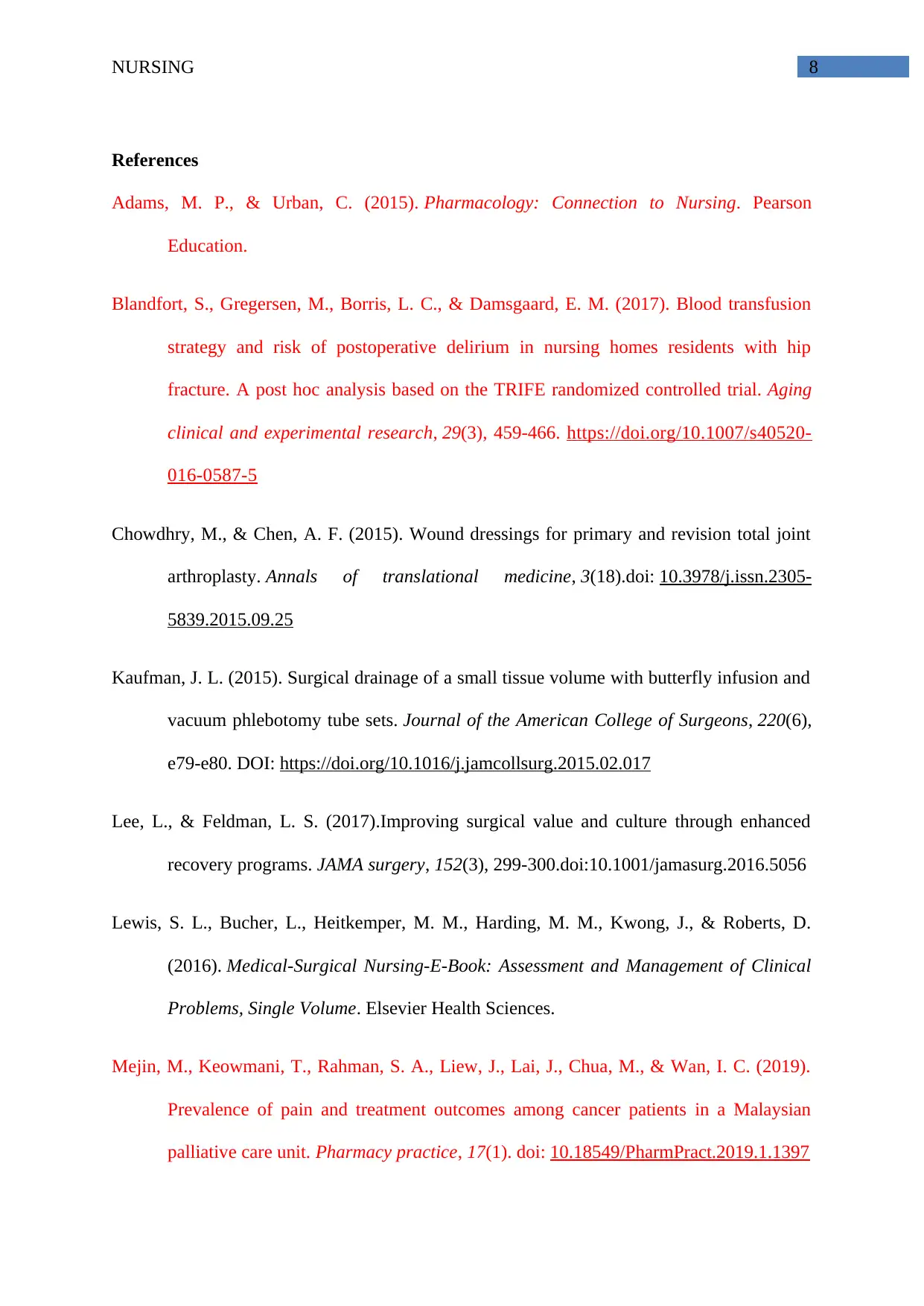
8NURSING
References
Adams, M. P., & Urban, C. (2015). Pharmacology: Connection to Nursing. Pearson
Education.
Blandfort, S., Gregersen, M., Borris, L. C., & Damsgaard, E. M. (2017). Blood transfusion
strategy and risk of postoperative delirium in nursing homes residents with hip
fracture. A post hoc analysis based on the TRIFE randomized controlled trial. Aging
clinical and experimental research, 29(3), 459-466. https://doi.org/10.1007/s40520-
016-0587-5
Chowdhry, M., & Chen, A. F. (2015). Wound dressings for primary and revision total joint
arthroplasty. Annals of translational medicine, 3(18).doi: 10.3978/j.issn.2305-
5839.2015.09.25
Kaufman, J. L. (2015). Surgical drainage of a small tissue volume with butterfly infusion and
vacuum phlebotomy tube sets. Journal of the American College of Surgeons, 220(6),
e79-e80. DOI: https://doi.org/10.1016/j.jamcollsurg.2015.02.017
Lee, L., & Feldman, L. S. (2017).Improving surgical value and culture through enhanced
recovery programs. JAMA surgery, 152(3), 299-300.doi:10.1001/jamasurg.2016.5056
Lewis, S. L., Bucher, L., Heitkemper, M. M., Harding, M. M., Kwong, J., & Roberts, D.
(2016). Medical-Surgical Nursing-E-Book: Assessment and Management of Clinical
Problems, Single Volume. Elsevier Health Sciences.
Mejin, M., Keowmani, T., Rahman, S. A., Liew, J., Lai, J., Chua, M., & Wan, I. C. (2019).
Prevalence of pain and treatment outcomes among cancer patients in a Malaysian
palliative care unit. Pharmacy practice, 17(1). doi: 10.18549/PharmPract.2019.1.1397
References
Adams, M. P., & Urban, C. (2015). Pharmacology: Connection to Nursing. Pearson
Education.
Blandfort, S., Gregersen, M., Borris, L. C., & Damsgaard, E. M. (2017). Blood transfusion
strategy and risk of postoperative delirium in nursing homes residents with hip
fracture. A post hoc analysis based on the TRIFE randomized controlled trial. Aging
clinical and experimental research, 29(3), 459-466. https://doi.org/10.1007/s40520-
016-0587-5
Chowdhry, M., & Chen, A. F. (2015). Wound dressings for primary and revision total joint
arthroplasty. Annals of translational medicine, 3(18).doi: 10.3978/j.issn.2305-
5839.2015.09.25
Kaufman, J. L. (2015). Surgical drainage of a small tissue volume with butterfly infusion and
vacuum phlebotomy tube sets. Journal of the American College of Surgeons, 220(6),
e79-e80. DOI: https://doi.org/10.1016/j.jamcollsurg.2015.02.017
Lee, L., & Feldman, L. S. (2017).Improving surgical value and culture through enhanced
recovery programs. JAMA surgery, 152(3), 299-300.doi:10.1001/jamasurg.2016.5056
Lewis, S. L., Bucher, L., Heitkemper, M. M., Harding, M. M., Kwong, J., & Roberts, D.
(2016). Medical-Surgical Nursing-E-Book: Assessment and Management of Clinical
Problems, Single Volume. Elsevier Health Sciences.
Mejin, M., Keowmani, T., Rahman, S. A., Liew, J., Lai, J., Chua, M., & Wan, I. C. (2019).
Prevalence of pain and treatment outcomes among cancer patients in a Malaysian
palliative care unit. Pharmacy practice, 17(1). doi: 10.18549/PharmPract.2019.1.1397
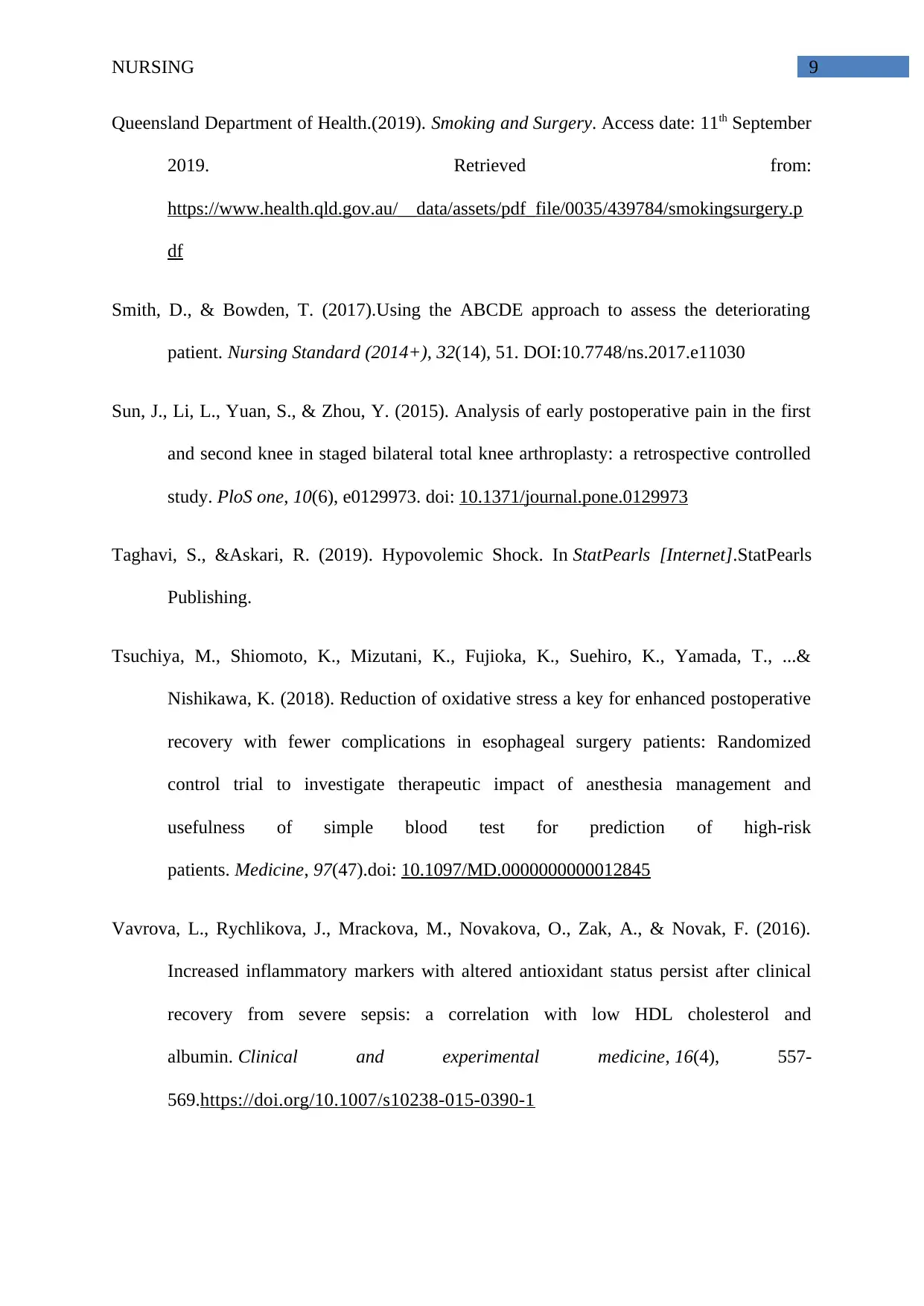
9NURSING
Queensland Department of Health.(2019). Smoking and Surgery. Access date: 11th September
2019. Retrieved from:
https://www.health.qld.gov.au/__data/assets/pdf_file/0035/439784/smokingsurgery.p
df
Smith, D., & Bowden, T. (2017).Using the ABCDE approach to assess the deteriorating
patient. Nursing Standard (2014+), 32(14), 51. DOI:10.7748/ns.2017.e11030
Sun, J., Li, L., Yuan, S., & Zhou, Y. (2015). Analysis of early postoperative pain in the first
and second knee in staged bilateral total knee arthroplasty: a retrospective controlled
study. PloS one, 10(6), e0129973. doi: 10.1371/journal.pone.0129973
Taghavi, S., &Askari, R. (2019). Hypovolemic Shock. In StatPearls [Internet].StatPearls
Publishing.
Tsuchiya, M., Shiomoto, K., Mizutani, K., Fujioka, K., Suehiro, K., Yamada, T., ...&
Nishikawa, K. (2018). Reduction of oxidative stress a key for enhanced postoperative
recovery with fewer complications in esophageal surgery patients: Randomized
control trial to investigate therapeutic impact of anesthesia management and
usefulness of simple blood test for prediction of high-risk
patients. Medicine, 97(47).doi: 10.1097/MD.0000000000012845
Vavrova, L., Rychlikova, J., Mrackova, M., Novakova, O., Zak, A., & Novak, F. (2016).
Increased inflammatory markers with altered antioxidant status persist after clinical
recovery from severe sepsis: a correlation with low HDL cholesterol and
albumin. Clinical and experimental medicine, 16(4), 557-
569.https://doi.org/10.1007/s10238-015-0390-1
Queensland Department of Health.(2019). Smoking and Surgery. Access date: 11th September
2019. Retrieved from:
https://www.health.qld.gov.au/__data/assets/pdf_file/0035/439784/smokingsurgery.p
df
Smith, D., & Bowden, T. (2017).Using the ABCDE approach to assess the deteriorating
patient. Nursing Standard (2014+), 32(14), 51. DOI:10.7748/ns.2017.e11030
Sun, J., Li, L., Yuan, S., & Zhou, Y. (2015). Analysis of early postoperative pain in the first
and second knee in staged bilateral total knee arthroplasty: a retrospective controlled
study. PloS one, 10(6), e0129973. doi: 10.1371/journal.pone.0129973
Taghavi, S., &Askari, R. (2019). Hypovolemic Shock. In StatPearls [Internet].StatPearls
Publishing.
Tsuchiya, M., Shiomoto, K., Mizutani, K., Fujioka, K., Suehiro, K., Yamada, T., ...&
Nishikawa, K. (2018). Reduction of oxidative stress a key for enhanced postoperative
recovery with fewer complications in esophageal surgery patients: Randomized
control trial to investigate therapeutic impact of anesthesia management and
usefulness of simple blood test for prediction of high-risk
patients. Medicine, 97(47).doi: 10.1097/MD.0000000000012845
Vavrova, L., Rychlikova, J., Mrackova, M., Novakova, O., Zak, A., & Novak, F. (2016).
Increased inflammatory markers with altered antioxidant status persist after clinical
recovery from severe sepsis: a correlation with low HDL cholesterol and
albumin. Clinical and experimental medicine, 16(4), 557-
569.https://doi.org/10.1007/s10238-015-0390-1
Secure Best Marks with AI Grader
Need help grading? Try our AI Grader for instant feedback on your assignments.
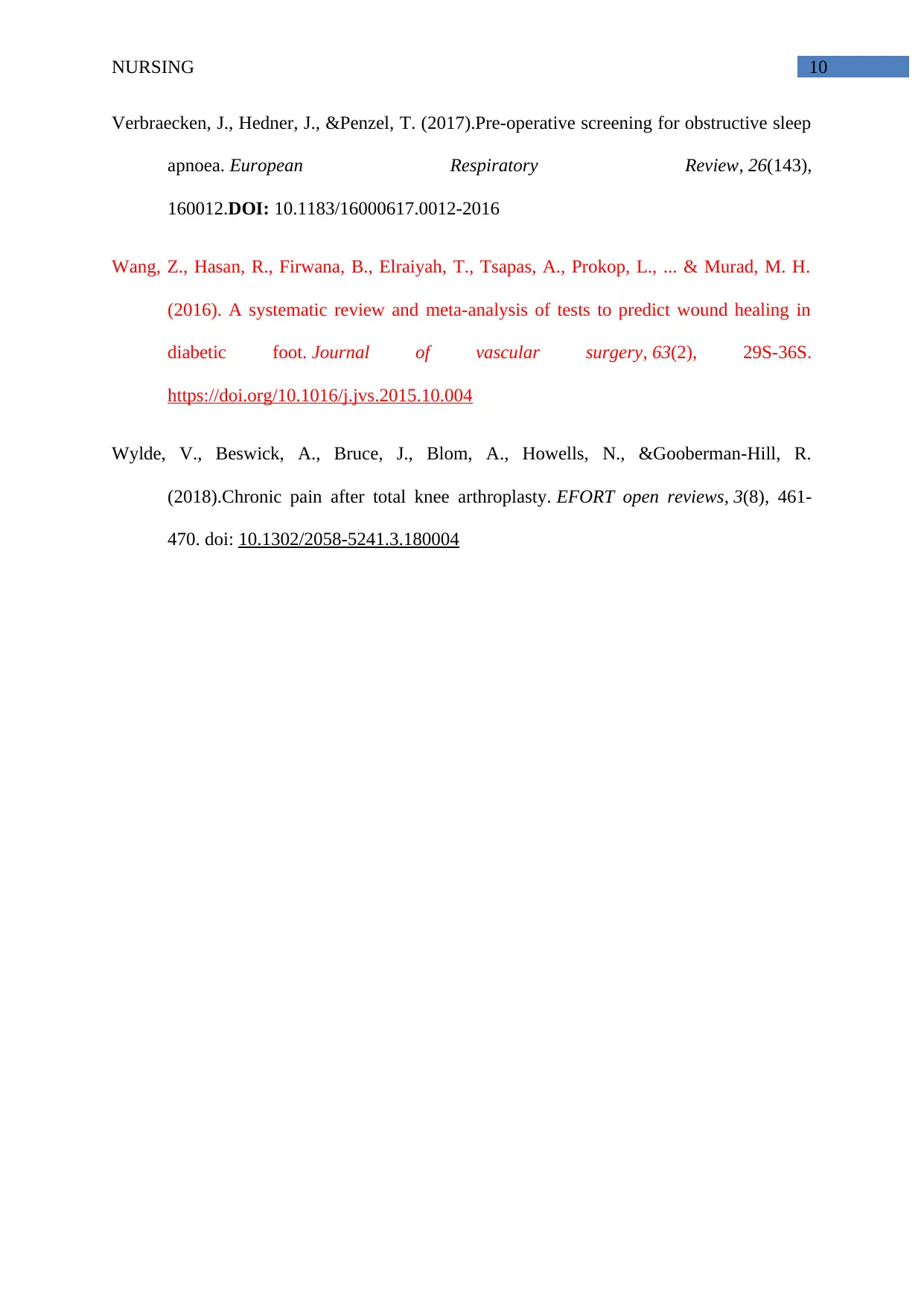
10NURSING
Verbraecken, J., Hedner, J., &Penzel, T. (2017).Pre-operative screening for obstructive sleep
apnoea. European Respiratory Review, 26(143),
160012.DOI: 10.1183/16000617.0012-2016
Wang, Z., Hasan, R., Firwana, B., Elraiyah, T., Tsapas, A., Prokop, L., ... & Murad, M. H.
(2016). A systematic review and meta-analysis of tests to predict wound healing in
diabetic foot. Journal of vascular surgery, 63(2), 29S-36S.
https://doi.org/10.1016/j.jvs.2015.10.004
Wylde, V., Beswick, A., Bruce, J., Blom, A., Howells, N., &Gooberman-Hill, R.
(2018).Chronic pain after total knee arthroplasty. EFORT open reviews, 3(8), 461-
470. doi: 10.1302/2058-5241.3.180004
Verbraecken, J., Hedner, J., &Penzel, T. (2017).Pre-operative screening for obstructive sleep
apnoea. European Respiratory Review, 26(143),
160012.DOI: 10.1183/16000617.0012-2016
Wang, Z., Hasan, R., Firwana, B., Elraiyah, T., Tsapas, A., Prokop, L., ... & Murad, M. H.
(2016). A systematic review and meta-analysis of tests to predict wound healing in
diabetic foot. Journal of vascular surgery, 63(2), 29S-36S.
https://doi.org/10.1016/j.jvs.2015.10.004
Wylde, V., Beswick, A., Bruce, J., Blom, A., Howells, N., &Gooberman-Hill, R.
(2018).Chronic pain after total knee arthroplasty. EFORT open reviews, 3(8), 461-
470. doi: 10.1302/2058-5241.3.180004
1 out of 11
Related Documents
Your All-in-One AI-Powered Toolkit for Academic Success.
+13062052269
info@desklib.com
Available 24*7 on WhatsApp / Email
![[object Object]](/_next/static/media/star-bottom.7253800d.svg)
Unlock your academic potential
© 2024 | Zucol Services PVT LTD | All rights reserved.





